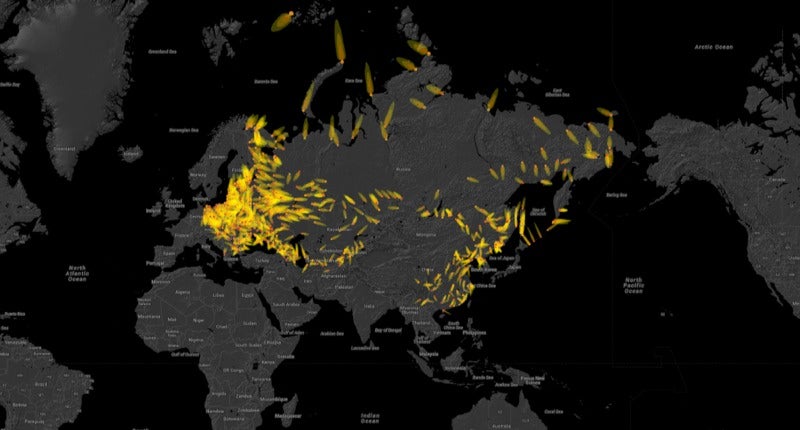 |
| Image: Future of Life/NUKEMAP |
The destructive power of nuclear bombs has been seared into our collective memory, thanks to archival images of the devastation of Hiroshima and Nagasaki. There’s the blast itself, and then all the radioactive fallout to contend with. A new interactive map shows what the damage from fallout would be if nuclear bombs were dropped on target cities today.
It’s the result of a collaboration between the Future of Life Institute (FLI)—a volunteer organization dedicated to decreasing existential threats to the human race co-founded by MIT physicist Max Tegmark—and Alex Wellerstein, a science historian at the Stevens Institute for Technology in New Jersey who developed the hugely popular NUKEMAP a few years ago. (Wellerstein was also the technical consultant for the stellar—and tragically cancelled—TV series, Manhattan.)
A few months ago, the National Security Archive released a 1956 US list of 1,100 nuclear targets in the Soviet Union, Eastern Bloc, China, and North Korea. FLI digitized the entire dataset, and approached Wellerstein about adapting NUKEMAP to the digitized targets. He realized he could use the new data to model nuclear fallout and possible casualties from detonated bombs.
 |
| Future of Life Institute’s digitized target map. Image: Future of Life/NUKEMAP |
Wellerstein ran two equally terrifying scenarios. First, he wondered what would have happened if bombs were dropped on all 1,100 targets on a single day: April 29, 2016. Second, he simulated how the direction of the radioactive fallout would change if bombs had been dropped on those targets on three consecutive days (April 29, April 30, and May 1, 2016).
There are many different factors that influence the extent of nuclear fallout, notably weather conditions and the size of the bomb. Wellerstein was able to draw on data from OpenWeatherMap to give his model realistic weather conditions on the days in question. But it also matters if the bomb detonates high in the air or on the ground; with the former, there is far less downwind fallout.
“This is because the fallout that makes the distinctive, high-radiation plume downwind of the weapon is largely made up of dirt or debris particles that have been sucked up into the radioactive fireball, and ‘fall out’ rather soon (within a few hours) after the blast,” Wellerstein told Gizmodo. “If the fireball avoids vaporizing dirt or debris, the radioactive products (the remains of the split atoms) stay hot and light longer, and thus in the upper atmosphere longer. They have longer to decay before they fall to the Earth, so the really radioactive stuff ‘burns out’ sooner and diffuses over a larger area.”
All the heavy fallout plumes in his visualization assume surface bursts, when in reality, there would likely be a mix of surface and airbursts, depending on the target. Bunkers or airfields, for instance, need heavier pressure to destroy, so those targets would probably require surface bursts. In contrast, homes and civilian buildings wouldn’t needed as much pressure, so airbursts would suffice for those kinds of targets.
There would also probably be more than one nuclear bomb per target in reality, since the military would expect that not every bomb would reach its target. NUKEMAP’s estimator assumes single detonations. So the really large casualty estimates in particular should be taken with a grain of salt, since there is likely to be some double counting of victims. But it’s probably a good ballpark figure if you add in longer-term casualties from fallout and the destruction of crucial infrastructures.
Those caveats aside, Wellerstein thinks the project still manages to illustrate the scope and magnitude of nuclear fallout from bombs dropped on those targets. Lest you think this is just an academic exercise: the declassified 1956 list of targets probably isn’t much different from the current US list, according to the FLI. And while most nuclear nations agree that less than 300 nuclear weapons are sufficient to achieve deterrence, the US alone has about 1900 warheads ready for deployment within 30 minutes. Russia’s not far behind. The threat of nuclear winter is closer than you might think.
Jennifer Ouellette [Motherboard and Nuclear Society]
Underground Nuclear Explosion Melt the Ground into a Giant Crater
US nuclear test film
Nuclear Bomb Dropped on Village - 1950s Test
1991 movie

Post a Comment Blogger Facebook Disqus